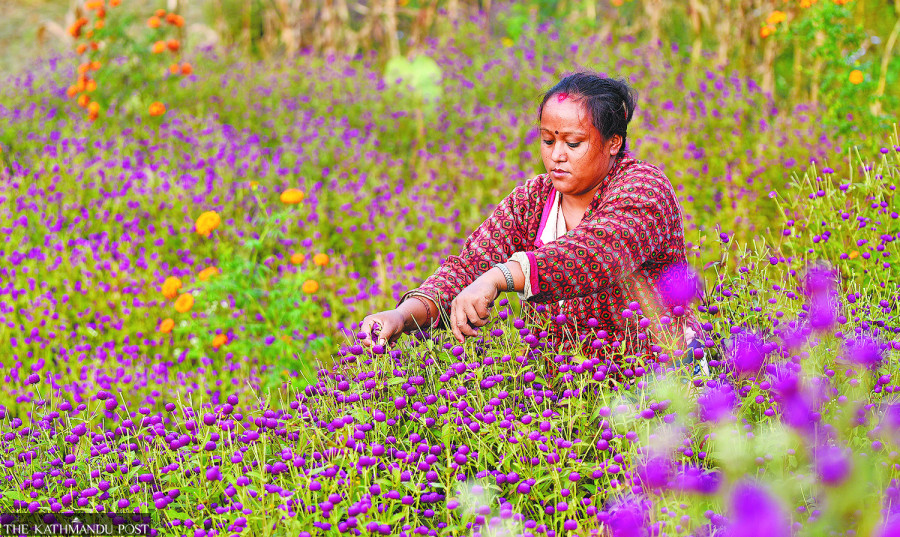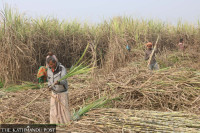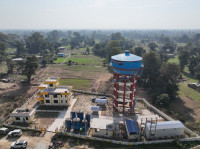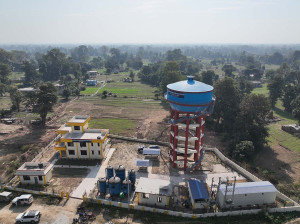Money
Tihar flowers likely to be in short supply due to rains
Garlands hold huge cultural significance during the festival as sisters put those made of makhamali and marigold flowers around their brothers’ necks.
Krishana Prasain
Tihar celebrators this year may have to pay more and look harder for the all-important flower garlands because last week's unseasonal downpour has damaged flower fields in Nepal and India, which is its main supplier, insiders said.
The festival of flowers and lights begins on November 3, and shopping for the necessities has already begun.
Garlands—makhamali or marigold flowers strung together for the occasion—hold huge cultural significance during this festival as sisters put them around their brothers' necks on the special day honouring their sacred bond.
“The October rains have caused a huge loss to flower producers. Marigold flowers that were ready to be shipped to market have been damaged in most districts,” said Min Bahadur Tamang, president of Floriculture Association Nepal. “This will push up imports and prices.”
He added, “We expect the wholesale price of metre-long marigold garlands to reach Rs60 this year compared to Rs40 during last year’s Tihar. The retail price may go up to Rs90 per garland."
A one-metre-long garland contains 40 flowers.
Marigold production has dropped in India too due to the October rains, according to Indian media reports.
Vibrant yellow marigolds and milky white chrysanthemums are necessary offerings to the goddess of wealth Laxmi during Tihar.
Colourful blossoms are a major item during the festival as people festoon the doors and windows of their houses with strings of flowers, and sisters place garlands around the neck of their brothers as part of the rituals.
Amrit Baniya, proprietor of Baniya Flowers and Gifts Shop at Narayan Gopal Chowk, said he had sold marigold garlands for Rs60 apiece last year. According to him, they may cost Rs90 this year due to reduced supply.
Florists say demand for marigold has jumped as many Nepalis who missed out on celebrating Tihar last year due to the Covid-19 scare plan to do so with more vigour this year.
Heavy rainfall is unusual in October, which is traditionally outside the monsoon season in Nepal.
The downpour started on October 17 in the western part of Nepal and moved east on October 19, claiming lives and damaging roads, bridges and other physical infrastructure besides standing crops in various districts.
The rain also destroyed ready-to-harvest flowers, particularly marigold.
“The incessant rainfall has affected production by 70 percent in Lumbini province,” Tamang said. “We have also received information that flowers in Chitwan, Makwanpur and Dhading have also been affected by the rainfall,” he added. “This year, we will mostly have to depend on imported flowers.”
According to Floriculture Association Nepal, the total national demand for flowers, mainly marigold, chrysanthemum (godawari) and globe amaranth (makhmali) this Tihar has been expected to hover around 1.8 million garlands, out of which marigold accounts for 1.5 million garlands .
Tamang said that domestic flower production would be sufficient for around 1.3 million marigold garlands, and the rest would have to be imported.
The association expects sales of local chrysanthemum and globe amaranth garlands to reach 300,000 units this year. Globe amaranth may cost Rs35-40 per garland, the association said.
Imported marigold flowers come mostly from Kolkata, India, as per Tamang.
During last year’s Tihar, around 1.35 million marigold garlands were consumed.
Marigold flowers are mainly produced in Kathmandu, Lalitpur, Bhaktapur, Chitwan, Dhading, Makwanpur, Nuwakot, Kabhre, Sindhuli, Bara, Sarlahi, Dhanusha and Siraha.
Baniya said that most of the inventory would have to be imported from India as domestic production is very low. He expects flower shipments for Tihar to start arriving from next week. “Due to rising demand, we are expecting brisk business during the festival.”
According to the association, floriculture is done on 158 hectares and around 44,000 people are directly and indirectly engaged in the sector. There are 800 commercial floriculturists in the country with a combined investment of Rs6.5 billion.
The floriculture sector suffered a big blow due to the Covid-19 pandemic in the last two years as the government banned all public gatherings, festivals and official events, and demand for cut flowers and flowers used in religious ceremonies evaporated.
But with the reopening of all sectors, flower traders are hopeful that the festival will bring cheer to them as people seem to be in a celebratory mood as was vividly demonstrated during Dashain.




 19.12°C Kathmandu
19.12°C Kathmandu













